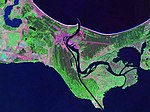Świnoujście Tunnel

The Świnoujście Tunnel (Polish: Tunel pod Świną) is a tunnel beneath the river Świna in Świnoujście, Poland, connecting the islands of Uznam and Wolin which separate the Szczecin Lagoon from the Baltic Sea in north western Poland. It constitutes the only fixed link between two parts of the city and subsequently between the rest of the country and the center of Świnoujście which prior to the tunnels opening in 2023 was accessible only by ferry. The tunnel carries route DK 93 of the Polish national roads network. On the left (west) bank of the river Świna, the tunnel begins at Karsiborska Street. On the right (west) bank, the tunnel joins Fińska Street leading to the end of the S3 Expressway which forms the Polish section of the European route E65. The existing ferry route is preserved for pedestrians and cyclists, slow moving vehicles and vehicles carrying dangerous substances which are prohibited in the tunnel.
Excerpt from the Wikipedia article Świnoujście Tunnel (License: CC BY-SA 3.0, Authors, Images).Świnoujście Tunnel
Tunel pod Świną, Świnoujście Śródmieście
Geographical coordinates (GPS) Address Website External links Nearby Places Show on map
Geographical coordinates (GPS)
| Latitude | Longitude |
|---|---|
| N 53.894166666667 ° | E 14.255 ° |
Address
Tunel pod Świną
72-606 Świnoujście, Śródmieście
West Pomeranian Voivodeship, Poland
Open on Google Maps










